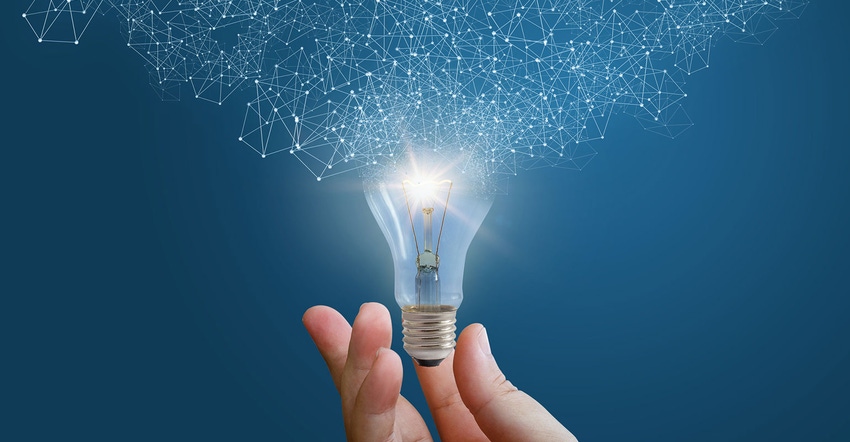Although challenges exist, the utility sector could emerge as an IIoT leader.
January 15, 2018

By Ryan Gerbrandt
Over the past decade, IT and communications technologies have continued to transform consumers’ lives. As all early adopters do, however, utilities have faced many challenges in adopting and integrating these technologies into their operations and customer relationships. Uncertainties remain, driven by the ongoing transformation of the utility business model and the need to integrate more renewables and other Distributed Energy Resources (DER) into the grid with the resulting exponential growth of data to manage. Yet, with the significant knowledge and insight acquired through years of innovating and applying smart grid technologies, utilities are in a compelling position to lead in the next wave of the Industrial Internet of Things (IIoT).
Utility-Defined Industrial Internet of Things
IIoT for utilities started with Advanced Metering Infrastructure (AMI), which was an integrated system of advanced meters, communications networks and data management systems that enabled two-way communications of customer, control and event data. Today, it has expanded to one of the largest industrial connectivity systems in the modern world.
AMI was only the beginning of IIoT for utilities, and gradually, understanding of the smart grid grew to include forms of automation across the distribution grid. Utilities began to discover costs and benefits to be gained from applications like asset management, outage management, voltage regulation and advanced distribution automation. In many cases, these applications used the very networks first built to deliver AMI communications.
[Internet of Things World demonstrates how the next generation of IoT will converge to unlock the intelligence of things in the industrial, enterprise and consumer realms. See what’s new for 2018.]
The path was not always without obstacles. Utilities were challenged to keep pace with the evolving use cases and technology requirements in this emerging space. From the beginning of the deployment of these intelligent meter devices to subsequent smart grid expansion/adoptions, utilities led the way in the adaptation and delivery of mission critical communications across different landscapes – balancing cost, access, privacy and security.
As a whole, the utility industry has come to appreciate the complexity and importance of enterprise-wide, integrated communications supporting mission critical, multi-application systems. Faced with a flood of new data from new sources from the dawn of the smart grid era, utilities began to face not only the challenge of capturing, managing and storing it, but also learning how to extract and identify actionable business intelligence from it. The industry’s traditional siloes, which separated operations and IT for example, meant systems couldn’t easily share or understand each other’s information.
What Did We Learn?
The early technology adopters at utilities often were hamstrung with limited focus, and locked into purpose-built, non-portable/extensible solutions. In the beginning, utility operations, many still siloed, may have had multiple smart devices and technologies, each capable of communicating only with their own make and model. As uses and requirements multiplied, the complexities and obstacles to integrating systems with narrow scope and never built to be connected became clearer.
Increasingly, utilities learned that keeping up with the rapidly evolving demands and the prospect of future growth, meant thinking far ahead. Any investment must include an element of future-proofing, particularly in the underlying platforms that support and enable new solution adoption.
Where Do We Go?
Today, utilities and utility networks by virtue of technology and experience garnered – are poised with the capability to play a central role in furthering the IIoT. The IIoT, the industrial core of the larger internet of things (IoT), represents a huge market. Accenture estimates IIoT could add $14.2 trillion to the global economy by 2030. A transformation promising to change how companies work – improving connectivity, efficiency, reliability and safety.
Utilities that have learned the critical lessons that led to today’s IIoT era, are equipped with insights to succeed. Their findings are relevant and applicable to many other industries facing connectivity challenges ahead.
Utilities have a head start, particularly in handling data securely, yet still face uncertainties as the increasing population and number of connected devices is not peaking anytime soon. As of 2017, there were 8.4 billion devices within the internet of things and that number is expected to reach 20.4 billion by 2020, according to Gartner. With this increase come new requirements for sustained performance and scalability of those connections.
More than ever, utilities need to keep up with this changing industry and invest in technology to find efficient ways to continue delivering services while generating revenue.
Lighting the Way
IIoT for utilities promises empowerment and opportunity enabling utilities to oversee communications that reach across and into the homes and workplaces of their customers. With a unified, global solution approach to utility communications, combined with the lessons utilities have already learned about security, privacy and engagement with consumers – utilities should embrace the uncertainty ahead and lead in the IIoT era. The challenges have shaped the communications platforms we have now, and because of them, utilities that take heed to the lessons of the past should be well-positioned to take lead in the IIoT era.
You May Also Like
.png?width=700&auto=webp&quality=80&disable=upscale)
.png?width=700&auto=webp&quality=80&disable=upscale)

.png?width=300&auto=webp&quality=80&disable=upscale)
.png?width=300&auto=webp&quality=80&disable=upscale)
.png?width=300&auto=webp&quality=80&disable=upscale)
